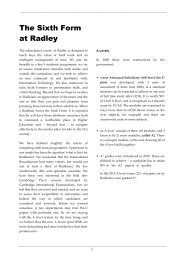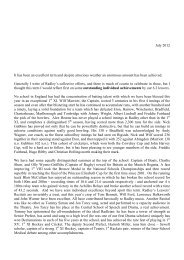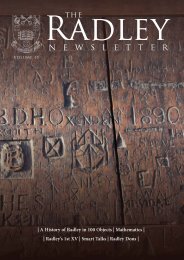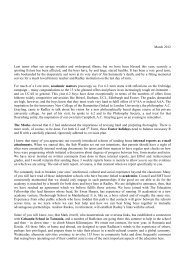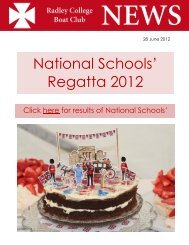Tony Money (1934) - Radley College
Tony Money (1934) - Radley College
Tony Money (1934) - Radley College
Create successful ePaper yourself
Turn your PDF publications into a flip-book with our unique Google optimized e-Paper software.
<strong>Tony</strong> <strong>Money</strong> (<strong>1934</strong>)<br />
THE RADLEY<br />
ALTARPIECE<br />
22 t h e o l d r a d l e i a n 2 0 0 6
The radley chapel altarpiece is a<br />
Retable, which stands free, either on<br />
the back of the altar or, as at <strong>Radley</strong>,<br />
on a pedestal behind it. In contrast, a<br />
Reredos is fixed to the wall behind the<br />
altar and rises from ground level.<br />
An altarpiece draws attention to an<br />
altar, and it also adorns it; but its essential<br />
liturgical function, pronounced by various<br />
synods from the 9th Century onward, is<br />
as a label to identify the saint to whom the<br />
altar is dedicated. Early on this was done<br />
by a silk-hanging or a wall-painting above<br />
the altar. The retable probably developed<br />
from these. It was a painted or carved<br />
panel (retro-tabularium = panel behind),<br />
sometimes in triptych form, which<br />
originally hung above the altar. A statue or<br />
an inscription were other permitted ways<br />
of identifying the saint.<br />
The altar symbolises Christ himself,<br />
his wounds represented by the five crosses<br />
carved in the medieval mensa (stone altartop,<br />
of which not many survive in place).<br />
It is also, as St. Paul says, ‘The Table of<br />
the Lord’, signifying the Lord’s Supper or<br />
Eucharist. Thus in the early Church only<br />
the sacramental vessels might be set upon<br />
the altar. In the 9th Century however<br />
a reliquary (a decorated receptacle for<br />
a martyr’s bones or other holy relics)<br />
was permitted on side altars; and by the<br />
end of the 11th Century it had become<br />
customary for a retable to be placed there,<br />
perhaps as a substitute for a reliquary. But<br />
this was still only possible for side altars,<br />
since at that time a priest stood behind<br />
the high altar, facing the congregation,<br />
and a retable there would have blocked<br />
their view of the host. By the 13th Century<br />
all the clergy stood in front of the high<br />
altar, with their backs turned on the<br />
congregation. As a result of this change<br />
of position a retable could now be placed<br />
on the high altar too. By the 15th Century<br />
an altar retable or reredos, or sometimes<br />
both, was almost universal.<br />
Medieval retables depicted scenes<br />
from Christ’s Passion, the Life of the<br />
Virgin together with the Infancy of Jesus,<br />
or incidents from the life of the Saint or<br />
Martyr to whom the altar was dedicated.<br />
The form of retables and their materials<br />
varied. The earliest carved ones were<br />
small and fashioned in low relief on a<br />
wooden core covered with gold-leaf, silver<br />
or gilded copper, and ornamented with<br />
enamel and cabochons (polished but uncut<br />
precious stones). That they were made<br />
from valuable materials explains why so<br />
few have survived. One of these is the<br />
Pala d’Oro (Golden Panel) in St. Mark’s,<br />
Venice. Made of gold in Constantinople<br />
in the 10th Century it shows Christ in<br />
Majesty, and also identifies the high altar<br />
with scenes from the life of St. Mark. A<br />
very few altarpieces survive from the 12th<br />
Century, carved in stone, a less expensive<br />
material. In the 13th Century retables in<br />
flat paintings on wooden panels became<br />
popular in Italy; they always remained<br />
so there in preference to carvings. From<br />
the 14th Century in Germany and the<br />
Low Countries retables were carved in<br />
wood, which was then gilded and painted<br />
(polychromed). They were encased in a<br />
wooden frame to protect the carvings,<br />
and they were provided with painted<br />
shutters which could enclose them<br />
completely and which were only opened<br />
on special occasions. Some of these<br />
shuttered wooden retables were also<br />
produced in northern France, but in the<br />
rest of the country stone was the chosen<br />
material. In Spain there are some very<br />
large and elaborate altarpieces which<br />
incorporate paintings and carvings in<br />
both wood and stone, as at Burgos.<br />
In England in the 14th Century<br />
a special form of stone reredos was<br />
developed. Carved in numerous niches for<br />
figures of Christ and the saints, it covers<br />
the entire wall behind the altar, blocking<br />
out the view beyond. Restored examples<br />
of this architectural form of reredos can<br />
be seen at Magdalen, All Souls and New<br />
<strong>College</strong>, Oxford, where the Chapel backs<br />
on to the Hall. Similar but free-standing<br />
walls of stone are the screens in large<br />
monastic churches, such as Winchester,<br />
Durham and St. Albans, which rise<br />
behind the nave altar, obscuring the view<br />
to the east window. They are no longer<br />
painted and gilded as once they were.<br />
Also dating from the 14th Century<br />
and more widespread were English<br />
alabaster retables, then known as ‘tables’.<br />
They were made from the soft stone first<br />
quarried at Chellaston in Derbyshire,<br />
and carved by craftsmen in Derby and<br />
Nottingham. Like the contemporary<br />
wooden retables of the Low Countries<br />
they consisted of carved groups of<br />
(alabaster) figures in a wooden frame of<br />
compartments; and probably like them,<br />
they were painted and gilded and had<br />
shutters. But they were very much smaller.<br />
This may be because in the English<br />
parish church the east chancel window<br />
is abnormally large, leaving only a few<br />
feet above the altar for an altarpiece. In<br />
effect the stained glass window with its<br />
Passion scene is the parochial altarpiece,<br />
and retables were probably more common<br />
on side altars at the east end of aisles and<br />
transepts where the windows are usually<br />
smaller. The alabaster retable industry,<br />
centred on Nottingham, exported large<br />
numbers of carved panels and triptychs as<br />
well as blocks of alabaster, to the Continent,<br />
to France in particular. Today many<br />
examples of these alabaster retables are<br />
found in churches and museums abroad,<br />
from Italy to Iceland. But in England itself<br />
few survive. In the 16th Century the Tudors<br />
appropriated the early retables for their<br />
precious materials; a century later these<br />
alabaster ‘tables’ were destroyed by Puritan<br />
iconoclasts. One survivor is in the church<br />
at Yarnton in Oxfordshire. There is also a<br />
substantial collection of pieces at the V &<br />
A.<br />
During the Renaissance sculpture<br />
became overshadowed by painting, except<br />
in Germany, with oil on canvas eventually<br />
replacing the original tempera on wooden<br />
panels of earlier painted triptychs. But<br />
the production of carved wooden retables<br />
continued in northern Europe until the<br />
mid-16th Century. It ceased when the<br />
Council of Trent (Trento) introduced<br />
regulations on church decoration. The<br />
tabernacle exposing the host for veneration<br />
became the most important as well as the<br />
largest object on the Catholic high altar,<br />
precluding the placing of a retable there.<br />
With the development of free-standing<br />
altars retables have become extinct in<br />
modern church furnishing.<br />
Brabant Retables<br />
The <strong>Radley</strong> altarpiece was made in<br />
Antwerp about 1515. At that time the Low<br />
Countries was the richest community in<br />
Europe, and after Italy the most cultivated.<br />
During the 15th Century, under the Dukes<br />
of Burgundy, wealth had accumulated<br />
from the trade and industry of the nearindependent<br />
cities with their rising middle<br />
class. At the same time the court of the<br />
Duke at Brussels was the most splendid of<br />
the age. These factors stimulated the arts<br />
and crafts and accelerated the large scale<br />
production of works of art. Antwerp on<br />
the Scheldt replaced Bruges in Flanders<br />
as the chief port of the region, and it<br />
quickly became the leading commercial<br />
centre of western Europe, profiting from<br />
the beginnings of colonial trade after<br />
the discoveries of the Portuguese and<br />
Spaniards. It also became the leading centre<br />
of international finance outside Italy.<br />
For a hundred years from the mid-15th<br />
t h e o l d r a d l e i a n 2 0 0 6<br />
23
The <strong>Radley</strong> Altarpiece<br />
’s-HERTOGENBOSCH (BOIS-LE-DUC), Netherlands<br />
Passion Altarpiece, Antwerp c. 1510-1520. Similar in date and appearence to the <strong>Radley</strong> Altarpiece.<br />
Iconography: Passion Cycle in upper register and on inside panels of wings; Childhood of Christ in bottom register;<br />
This is how the <strong>Radley</strong> Altarpiece would have looked with its wings.<br />
Closed during the week. Opened on Sundays and/or special days in the Church calendar.<br />
to the mid-16th Century, workshops centred<br />
on three cities of the Duchy of Brabant–<br />
Antwerp, Brussels and Mechelen (Malines)<br />
– produced carved wooden retables at an<br />
extraordinary rate. They were not only<br />
produced to order, but there was a supply<br />
ready to meet the commercial demand.<br />
Mr. Hans Nieuwdorp of the Mayer van den<br />
Bergh Museum in Antwerp estimates that<br />
retables were made at the rate of some three<br />
hundred a year, with reproduction time<br />
from start to finish being three months of<br />
hard work. Of this potential output of some<br />
thirty thousand retables between four and<br />
five hundred only have survived, of which<br />
three hundred are complete or nearly so;<br />
those with their original shutters remaining<br />
number not even a hundred. If these<br />
estimates are correct the <strong>Radley</strong> altarpiece is<br />
part of that one per cent of total production<br />
that survives today more or less intact. Most<br />
of these are of 16th rather than 15th century<br />
origin.<br />
Orders came principally from wealthy<br />
patrons for cathedrals, abbeys, and<br />
churches; but not just from the prelates.<br />
From about 1480 lay brotherhoods,<br />
city corporations and trade guilds<br />
increasingly commissioned retables in<br />
side chapels devoted to their body. In so<br />
doing they reflected both the prosperity<br />
and the piety of the time. In cathedrals<br />
and large churches there would be<br />
numerous such altars (at St. Gallen in<br />
Switzerland there were seventy), where<br />
masses were said for benefactors and the<br />
repose of the faithful departed. Smaller<br />
altarpieces were also made for private<br />
devotion. The carving of single figures<br />
was a speciality of Mechelen, situated half<br />
way between Brussels and Antwerp. As a<br />
centre of commerce Antwerp became the<br />
market for Brussels and Mechelen as well,<br />
and from its busy port Brabant retables<br />
were exported as return cargo all over<br />
Europe, but principally to Spain, northern<br />
France, Germany and Scandinavia. There<br />
is documentary evidence that Brabant<br />
altarpieces were also exported to England<br />
and Scotland, but none of these are now<br />
traceable.<br />
Germany too was famous for its<br />
carved wooden retables. In the north<br />
these, as in the Low Countries, were<br />
made of oak or sometimes of walnut.<br />
Lübeck was one of the main centres of<br />
production, with an important export<br />
trade around the Baltic. But southern<br />
Germany has the broad-leafed lime. This<br />
is of a softer wood, easier to carve than<br />
oak, with so beautiful a surface that many<br />
of these altarpieces were never gilded or<br />
polychromed. Most of those surviving are<br />
by a known master. In German retables<br />
individual figures are large, filling their<br />
compartment; in contrast to the Brabant<br />
retables which are crowded with many<br />
small figures.<br />
Description<br />
As can be seen in the <strong>Radley</strong> altarpiece,<br />
a Brabant retable has a rectilinear case,<br />
divided into three compartments, the<br />
central one of which rises higher than<br />
the others. At the end of the 15th and the<br />
beginning of the 16th Century the top of<br />
the retable evolved from the horizontal<br />
line as in the <strong>Radley</strong> one, through a<br />
variety of curves, to a continuous line<br />
of accolades. The outline of the top is a<br />
pointer towards the dating of the retable.<br />
24 t h e o l d r a d l e i a n 2 0 0 6
The three compartments were normally,<br />
in Antwerp workshops anyway, divided<br />
horizontally into a larger upper and a<br />
smaller lower space. Each of these spaces<br />
was crowned by architectural decorations<br />
in the form of curved tracery. Below was<br />
a group of carved figures enacting part of<br />
a continuous story. Wings (shutters) were<br />
attached to the sides of the case. They<br />
are missing in the <strong>Radley</strong> retable. Their<br />
combined breadth equalled that of the<br />
carved portion, producing a very wide<br />
structure when open. In a large retable the<br />
wings on each side would be divided into<br />
two panels. The insides of the wings were<br />
sometimes carved but were more often<br />
painted. The outsides were always painted.<br />
The origin of these north European<br />
shuttered retables probably stems from<br />
the reliquaries in which the bones of the<br />
saint were presented behind locked doors.<br />
When closed the retables resembled<br />
these reliquaries, and they normally were<br />
closed, concealing not bones but carvings,<br />
although in some cases retables would<br />
enclose reliquaries as well. Sometimes<br />
there was a second pair of wings (shutters)<br />
behind the inner one. This would provide<br />
an intermediate stage between the<br />
normal everyday closure and the display<br />
of the carvings flanked by paintings<br />
when the inner wings were opened. This<br />
intermediate stage would show an entirely<br />
painted polyptych made up of the inside<br />
of the outer wings and the outside of<br />
the inner ones. This would probably be<br />
the Sunday show, while the display of<br />
the inner carvings would be confined to<br />
special periods during the Church year,<br />
according to the narrative content. Apart<br />
from their liturgical purpose, the shutters<br />
provided security from northern damp<br />
and cold<br />
which could affect both wood and<br />
polychromy, and also from candle-smoke,<br />
dust and accidental damage.<br />
These altarpieces have been called<br />
‘The Bible of the Poor’. They were both<br />
narrative and didactic. On them the<br />
illiterate worshippers could recognise<br />
stories they had heard and pick out<br />
individuals mentioned in them. But the<br />
veneration accorded to these images<br />
was cause for concern, long before the<br />
Reformation, among those in the Church<br />
worried by the growth of image-worship<br />
in defiance of the Commandment.<br />
The interior sculpted groups told a<br />
story which would often extend to the<br />
interior painting of the wings. The story<br />
would show the Passion Cycle, or the<br />
Altarpiece closed showing Christ’s Ministry on outer panels of wings;<br />
Wedding at Cana on left, Raising of Lazarus on right, Temptation of Christ on top.<br />
Life of the Virgin, or of an individual<br />
saint. A popular story was of St. Anne,<br />
the mother of Mary. Incidents from<br />
her life were based on the apocryphal<br />
evangelists and other mystical writings.<br />
The Passion Cycle is the most common<br />
iconographical theme. To this are often<br />
joined illustrations of the Infancy of Jesus,<br />
which also tell of the life of the Virgin.<br />
These Infancy illustrations are normally<br />
shown in the smaller lower register, as in<br />
the <strong>Radley</strong> altarpiece. (In contrast to later<br />
religious art, in medieval imagery there<br />
are few illustrations of Christ’s teaching,<br />
such as the parables.)<br />
The story represented begins most<br />
often in the interior paintings of the left<br />
wing, continues in the carvings contained<br />
in the case from left to right, and finishes<br />
on the interior paintings of the right wing,<br />
and sometimes even on the outer side of<br />
the wings. In some retables the inner side<br />
of the wings tells a different story from<br />
the carvings, possibly of the patron saint<br />
of the church or altar. He or she usually<br />
occupied a prominent position, sometimes<br />
taking over the whole retable. Not all the<br />
saints who featured were canonised. These<br />
others were popular local saints, whose<br />
legendary wonders and miracles on behalf<br />
of those in sickness, plague or other need<br />
were displayed in episodes in the retable.<br />
On the exterior of the shutters, which was<br />
the everyday view, traditional figures were<br />
usually painted. These might be the patron<br />
saint of the altar, the four evangelists,<br />
or the four great Church teachers, St.<br />
Ambrose, St. Augustine, St. Hieronymus<br />
and St. Gregory the Great. A very popular<br />
theme was the miraculous Mass of St.<br />
Gregory, which was a means whereby<br />
believers, provided they recited the<br />
requisite prayers, could win a substantial<br />
number of years’ indulgence in Purgatory.<br />
Manufacture<br />
Many figures were sculpted individually,<br />
but it was also usual for a group of figures<br />
to be carved from the same piece of<br />
wood. After they had been carved the<br />
figures were gilded and polychromed,<br />
as were the background furniture, the<br />
architectural decoration at the top of each<br />
compartment, and the outer case. The<br />
t h e o l d r a d l e i a n 2 0 0 6<br />
25
The <strong>Radley</strong> Altarpiece<br />
Opitter, Belgium. Antwerp c. 1540 Passion Altarpiece<br />
gold and colours were never painted on<br />
the wood itself but always on a coating<br />
of gesso (size and chalk). This was<br />
mostly applied in several layers, so that<br />
in some places the carver needed to put<br />
the finishing touches to his work after<br />
the gesso had been applied, in order to<br />
recreate the finer details of his carving in<br />
the gesso itself.<br />
The Antwerp workshops tended to<br />
use more gilding than those at Brussels<br />
and Mechelen. Probably some 80% was<br />
gilded. It was nearly all polished gold, i.e.<br />
the gilder polished with a stone the gold<br />
leaf he had applied to the surface. Matt<br />
gold was employed, as were the colours, to<br />
bring out the effect of the polished gold.<br />
Only small amounts of silver were used,<br />
mainly for armour and weapons. It was<br />
protected by a varnish coating to prevent<br />
its blackening with age. Colours used were<br />
normally limited to red, blue, green, black<br />
and white. Flesh was coloured naturally,<br />
with female faces whiter and male darker;<br />
hair too, though it was often golden. Other<br />
colour was mainly used on the inside of<br />
clothing where visible, red, blue and green.<br />
The base of a scene, if out of doors, was<br />
often green.<br />
Polychromy provided not only colour<br />
but also texture, and this was particularly<br />
important in representing the many<br />
different clothing surfaces – silk, satin,<br />
velvet, damask, brocade etc. Gold leaf<br />
was laid over the gesso surface and any<br />
overlying colour gained richness and body<br />
from the gold below. Glossy surfaces on<br />
drapery were achieved by mixing oil or<br />
resin with the paint. Weaves would be<br />
indicated by striations. Patterns could<br />
be modelled in the gesso, or painted,<br />
punched or engraved on the polished gold.<br />
The sgraffito method involved painting<br />
a gold surface with red or blue, and then<br />
with a sharp point revealing some of the<br />
gold underneath in a decorative textile<br />
design such as spiral, rosettes or letters.<br />
A special technique of imitating Italian<br />
brocade was to engrave a design on a<br />
metal template, previously cut and shaped.<br />
On this mould a mixture of beeswax<br />
and resin, liquefied by heat, was applied.<br />
When cooled, this skin was detached,<br />
gilded, and painted before being applied<br />
(appliqué) to the figure or furniture.<br />
Finally facial features, beards, moustaches,<br />
and particularly eyes needed to be painted<br />
in with great care in order to bring to life<br />
the carved figures.<br />
The making of a retable engaged a<br />
number of different craftsmen. Originally<br />
these were three, the case-maker who<br />
made the case and the shutters, the carver<br />
who sculpted, and the painter who painted<br />
the shutters and gilded and painted<br />
the carvings. As production rose, more<br />
specialisation occurred: between gilder<br />
and painter, and between the figure carver<br />
and the man who carved the architectural<br />
decoration. In some workshops the three<br />
crafts would work together under a<br />
master; sometimes their workshops were<br />
separate. When the figures and other<br />
parts had been carved they were gilded<br />
and painted. They were then finally fitted<br />
26 t h e o l d r a d l e i a n 2 0 0 6
together in the case, in which they were<br />
held by dowel pegs. The wings were<br />
attached to the case by metal hinges after<br />
an artist had completed the paintings<br />
on them. The figures in these paintings<br />
were larger than the carved figures; in<br />
German retables, in contrast, they were<br />
smaller. There were three separate guilds<br />
for these varied professions at Brussels,<br />
but at Antwerp the Guild of St. Luke,<br />
the imagined artist of the Apostles, was<br />
responsible for the whole work. This made<br />
control easier and was one of the reasons<br />
that the market of the Pand at Antwerp<br />
also handled the Brussels production.<br />
To maintain quality the guilds<br />
were very strict in their control of the<br />
materials used. Guild officials could enter<br />
a workshop at any time to ensure that<br />
regulations were being observed. Only<br />
blocks of unblemished oak or walnut,<br />
sawn perpendicularly to the diameter of<br />
the tree, might be used. Only gold leaf<br />
and pigments of the correct quality were<br />
permitted. As a guarantee of quality of<br />
material stamps were branded into the<br />
bare wood. This is usual for precious<br />
metals, but for wood to be marked in<br />
this way is unique. The Antwerp stamp<br />
was the open hand, derived from the city<br />
arms, burnt into the bare wood. There are<br />
many such hands visible on the <strong>Radley</strong><br />
altarpiece, either at the base of a group or<br />
on top of a head. Each hand guarantees<br />
the quality of the wood it is stamped on.<br />
The Castle of Antwerp stamp guaranteed<br />
the quality of the materials used in the<br />
polychromy. This appeared on the outside<br />
of the case, sometimes accompanied by<br />
a double hand, which may have been<br />
a guarantee for the gold leaf. Brussels<br />
and Mechelen had their own particular<br />
marks. These marks do not guarantee the<br />
aesthetic quality of the work, merely the<br />
quality of the materials used, and the city<br />
of origin.<br />
If it is of superior artistic quality an<br />
expert can usually tell from the style alone<br />
whether a retable come from Antwerp,<br />
Brussels or Mechelen. Very few Mechelen<br />
retables have survived. The Brussels<br />
workshops produced the finest work<br />
during the late Gothic period at the end of<br />
the 15th Century.<br />
By the time that Antwerp had<br />
increased its production at the start of<br />
the 16th Century the influence of the<br />
Italian Renaissance, late in arriving in<br />
northern Europe, was making itself<br />
felt. Flemish copybooks of Renaissance<br />
architectural motifs are widespread.<br />
The opened altarpiece (left) is completely devoted to the story of the Passion.<br />
The closed altarpiece (above) features scenes from Christ’s Ministry<br />
This often resulted in a hybrid mixture<br />
of Gothic and Classical ornamentation.<br />
With the ending of the Middle Ages the<br />
attitudes and expressions of the figures<br />
are changing. Figures in early retables are<br />
calm, reserved and spiritually moving, and<br />
the composition is uncluttered. In the 16th<br />
Century figures become more vehement,<br />
bodies are twisted, dress is more secular,<br />
and the composition is crowded and<br />
restless. Some of this change can be seen<br />
in the <strong>Radley</strong> altarpiece.<br />
The great demand for retables both<br />
in the Low Countries and abroad at the<br />
turn of the 15th/16th Century led to a<br />
thriving retable industry. Although the<br />
standard of craftsmanship is high, the<br />
artistic quality of these ‘commercial’ pieces<br />
is naturally not so good as those made<br />
for a special commission. The <strong>Radley</strong><br />
retable is one of those made for sale in<br />
the market. It is typical of Antwerp work<br />
of the period. Some figures are skimped<br />
in that only what can be seen is carved.<br />
It was a common practice, particularly<br />
in ready-made work, not to carve what<br />
was not visible. But the work of the 19th<br />
century gilder, which obscures all flesh and<br />
other colours, makes a proper appreciation<br />
difficult.<br />
Later History<br />
If only 1% of some 30,000 altarpieces from<br />
Brabant survive today, where are these to<br />
be found, and what has happened to the<br />
rest? Those surviving are most numerous<br />
in northern Germany (over 100), and in<br />
France and Sweden around Stockholm<br />
(about 40 each). There are some in<br />
Portugal, Spain, the Netherlands, Austria,<br />
Denmark and Poland, and one or two<br />
in Finland and the former Soviet Union.<br />
There are also some 30 in Belgium itself.<br />
This pattern relates to the Reformation.<br />
Where Lutheranism prevailed the churches<br />
remained undesecrated, although there<br />
was no further demand for retables. Where<br />
Calvinism or other Reformed Churches<br />
gained supremacy, there was universal<br />
iconoclasm and destruction of altarpieces.<br />
t h e o l d r a d l e i a n 2 0 0 6<br />
27
The <strong>Radley</strong> Altarpiece<br />
The Rhineland is a region adjacent to<br />
the Low Countries, so it was natural for<br />
Brabant altarpieces to be in some demand<br />
there, although there was a home-based<br />
industry in the German style. At the<br />
Reformation the Rhineland remained<br />
mostly Catholic with some pockets of<br />
Lutheranism. As a result there are many<br />
Brabant retables to be found today in the<br />
small villages west of Cologne between<br />
the Rhine and the Meuse. In some<br />
churches there are two or three. (Today<br />
the churches are normally locked for<br />
protection against robbers.) Further east,<br />
northern Germany was solidly Lutheran<br />
and many retables survive.<br />
In Sweden the importation of north<br />
German retables from Lübeck and<br />
elsewhere gave way towards the end<br />
of the 15th Century to imports from<br />
Brabant. These continued steadily until<br />
the 1520s when the Lutheran reform put<br />
an end to them, as it did in Denmark.<br />
The Swedish retables are among the<br />
finest remaining today. Spain, Portugal<br />
and Poland remained Catholic, and in<br />
France the Huguenots were a minority,<br />
so these countries suffered no loss at the<br />
time, although France was much later to<br />
undergo the destruction of the Revolution.<br />
In the Low Countries itself the<br />
Reformation was a disaster for the<br />
industry. Antwerp became a centre<br />
of Reforming activity. The wars of<br />
religion and national revolt against the<br />
Habsburgs caused widespread destruction<br />
and iconoclasm. In a few days in 1566<br />
hundreds of churches were desecrated<br />
by the Calvinists. The sack of Antwerp<br />
28 t h e o l d r a d l e i a n 2 0 0 6
y Spanish soldiers in 1576 caused<br />
the massacre of 8,000 citizens. In 1585<br />
Antwerp surrendered to the Spaniards to<br />
remain faithful to the old religion. The<br />
Scheldt was closed to shipping, the city’s<br />
commercial importance was destroyed,<br />
and within four years the population<br />
diminished from 80,000 to 42,000. The<br />
French Revolution completed what the<br />
earlier iconoclasm had begun. Retables<br />
are to be seen in Belgium today in a<br />
number of churches and especially in the<br />
Museum of Art and History at Brussels,<br />
where retables of different styles and<br />
dates can be compared.<br />
In the now independent northern<br />
Netherlands where capital and<br />
enterprise had migrated from the south,<br />
Calvinists and Anabaptists carried out<br />
the destruction of idolatrous images<br />
in the churches. There had been some<br />
production of retables in Utrecht,<br />
Breda and other Dutch cities, but today<br />
only three or four of these survive in<br />
the whole of the Low Countries. The<br />
same story of destruction is true of the<br />
Upper Rhine and Switzerland, where the<br />
Reformed Churches held sway.<br />
In the years since the Reformation,<br />
wars, revolution, fires, neglect and a<br />
change in taste have brought about<br />
the destruction of many more of these<br />
carved altarpieces. Of those remaining<br />
today about 80% date from the period<br />
1490 to 1530; only 10% are from the<br />
beginning, about 1390 up to 1490; and<br />
10% from 1530 to the end, about 1560.<br />
The <strong>Radley</strong> Altarpiece<br />
The Neo-Gothic Revival started in<br />
England, and enthusiasm for things<br />
Gothic led to the importation of much<br />
ecclesiastical furniture in the first<br />
part of the 19th Century. The Revd.<br />
William Sewell in founding St. Peter’s<br />
<strong>College</strong>, <strong>Radley</strong> in 1847 had as one of<br />
his aims the inspiration of the boys by<br />
surrounding them with beautiful things.<br />
The Chapel, as the central point of<br />
the school, was filled with much old<br />
and some new Gothic furniture which<br />
Sewell bought from London dealers or<br />
had made in Gloucester and Oxford. In<br />
1847, just before <strong>Radley</strong> <strong>College</strong>’s first<br />
term Sewell bought the Altarpiece from<br />
Samuel Luke Pratt for £190. Pratt was<br />
‘cabinet maker, upholsterer and importer<br />
of ancient furniture, armour etc.’, whose<br />
shop was at 147 New Bond Street,<br />
London. However, the Revd. Robert<br />
Singleton, co-founder and first Warden<br />
wrote in his Diary: ‘It is very fine indeed<br />
in its way; but it is quite too graphic to<br />
be reverent, and as it also bears a very<br />
Popish air, all thought it best to get rid of<br />
it. J.E.S. and H.S. [Sewell’s brothers] felt<br />
strongly against, and my own personal<br />
repugnance was great. So it was sent<br />
back to Pratt today.’<br />
In 1853, by which time Singleton<br />
had left <strong>Radley</strong> after disputes with<br />
Sewell and Sewell had later returned as<br />
<strong>Radley</strong>’s third Warden, the altarpiece<br />
reappeared in the Old Chapel. In a<br />
sermon Sewell told the boys: ‘It was<br />
wished that as the chapel itself was to be<br />
distinguished from the other buildings,<br />
so the east end of the chapel itself should<br />
be distinguished from the other part,<br />
according to the known customary<br />
principle of the Catholic, and therefore<br />
the English Church – distinguished by<br />
some more than ordinary decoration,<br />
because there is the place for the table<br />
of the Lord. Circumstances into which<br />
it is unnecessary to enter prevented its<br />
being erected at that time…. I have now<br />
wished to fix this ornament in the place<br />
for which it was originally intended<br />
when I purchased it, six years since.’ In<br />
his unpublished Reminiscences (1866)<br />
Sewell wrote: ‘I had found it too strongly<br />
accentuated when it was coloured, and I<br />
softened it by having it silvered and gilt’.<br />
For a century and a half the<br />
Altarpiece has been a prominent feature<br />
in the active religious life of <strong>Radley</strong><br />
Chapel. The only other Brabant retable<br />
in ecclesiastical use in this country is<br />
in Carlisle Cathedral. Also made in<br />
Antwerp and now without its wings,<br />
it has been restored by the V & A<br />
Museum and is on permanent loan from<br />
Brougham Castle. There is an Antwerp<br />
retable at Towneley Hall Art Gallery,<br />
Burnley, and one from Brussels at the<br />
Bowes Museum, Barnard Castle, Co.<br />
Durham. This is complete with wings,<br />
as is the Antwerp one in the disused<br />
chapel at Oxburgh Hall, Norfolk, the seat<br />
of an old Catholic family. In Batheaston<br />
Church, Bath, there are the wings only of<br />
a retable.<br />
Iconography<br />
The <strong>Radley</strong> altarpiece is worth a study<br />
in detail. One has to imagine the<br />
painted wings; the marks of the hinges<br />
are visible at the top of the case. There<br />
are some difficulties of interpretation<br />
in the altarpiece. Each Passion retable<br />
was an individual work, but the most<br />
common iconography is for the left<br />
compartment to contain the Ascent to<br />
Calvary with Christ carrying his Cross;<br />
in the centre the Crucifixion; and on the<br />
right the Descent (Deposition) from the<br />
Cross, or the Lamentation before the<br />
entombment, or sometimes the former<br />
above the latter.<br />
The individuals who appear most<br />
often in these Passion scenes with<br />
Christ are the Virgin, St. John, Joseph<br />
of Arimathea, Nicodemus and Mary<br />
Magdalene. St. John is the writer of the<br />
Gospel in which he refers to himself as<br />
‘the disciple whom Jesus loved’. Jesus<br />
commends him to his mother with<br />
the words ‘Woman, behold thy son’,<br />
and John is normally shown with her.<br />
In the Crucifixion scene the Virgin<br />
traditionally stands at the foot of the<br />
Cross on Jesus’s right and John is on his<br />
left, or more often she is swooning into<br />
John’s arms. They also appear together<br />
in the Deposition and Lamentation<br />
scenes. John, the youngest of the<br />
Apostles, is shown beardless with long,<br />
flowing curly hair. Joseph of Arimathea,<br />
the ‘man of means’, is richly dressed. It<br />
is he who obtained Pilate’s permission<br />
to remove Christ’s body from the<br />
Cross for burial in his own tomb. This<br />
is mentioned briefly in the Gospels,<br />
but the Deposition scene appears very<br />
frequently in Passion retables. Joseph<br />
helps to lower the body from the Cross.<br />
In the Lamentation he supports the<br />
corpse or stands by, sometimes holding<br />
the Crown of Thorns or the linen<br />
shroud. His iconographical attributes,<br />
by which he may be recognised, are<br />
the Crown of Thorns, the Nails from<br />
the Cross, and the Shroud. Nicodemus,<br />
a Pharisee, was like Joseph a secret<br />
disciple while a member of the<br />
Sanhedrin, the Jewish Council. He came<br />
to Jesus by night for instruction. He is<br />
mentioned only in John’s Gospel. He is<br />
normally shown assisting Joseph in the<br />
Deposition and Lamentation scenes.<br />
In the former he is sometimes shown<br />
removing the nails from Christ’s left<br />
hand with pincers. This derives from<br />
the apocryphal Gospel of Nicodemus.<br />
Joseph is distinguished from him by his<br />
richer clothing. Mary Magdalene, or<br />
Mary of Magdala, the reformed harlot<br />
who anointed Christ’s feet while he was<br />
at supper, represents the Church’s image<br />
of a penitent sinner and as such was a<br />
popular figure in Christian art. A jar of<br />
ointment is her symbolic attribute. Her<br />
t h e o l d r a d l e i a n 2 0 0 6<br />
29
The <strong>Radley</strong> Altarpiece<br />
hair is long and flowing and golden, and<br />
she is richly dressed in a red cloak. She<br />
is normally seen at Christ’s feet in the<br />
Deposition and Lamentation scenes.<br />
Below the Passion scenes are often<br />
to be found Infancy panels which<br />
portray the traditional scenes for<br />
the Annunciation, the Nativity, the<br />
Circumcision, the Presentation in the<br />
Temple, the Adoration of the Magi, or<br />
the Flight into Egypt. In the centre of<br />
these Infancy scenes the Tree of Jesse<br />
very often appears. Scenes or figures<br />
from the Old Testament are not often<br />
featured prominently in these retables,<br />
but the Tree of Jesse is an exception. It<br />
is a common subject of medieval art,<br />
combining the prophecy of Isaiah with<br />
the genealogical descent of Christ from<br />
King David and his father Jesse, as given<br />
in the first chapter of Matthew. The line<br />
of Jesse continues up either side of the<br />
Crucifixion scene in the branches of the<br />
tree.<br />
All the characters mentioned above<br />
can be identified in the <strong>Radley</strong> altarpiece.<br />
But a number of figures appear who<br />
cannot be named – with certainty. This is<br />
partly because of the 19th entury gilding<br />
which covers everything. But it is also<br />
very probable that over the centuries<br />
single figures or groups of figures have<br />
been moved around; that identifying<br />
implements held by individual figures<br />
have been lost and incorrectly replaced;<br />
and that where figures or groups of<br />
figures were missing, they have been<br />
replaced from an outside source. This<br />
was common practice among 19th<br />
century dealers and restorers.<br />
The Crowning with Thorns<br />
This pre-Crucifixion scene shown in the<br />
<strong>Radley</strong> altarpiece is less common in art<br />
than is the Ascent to Calvary which it<br />
replaces. It takes place during the second<br />
mocking, by Roman soldiers in the<br />
courtyard of their praetorium (HQ). The<br />
soldiers are in costume contemporary<br />
with the altarpiece, which is normal.<br />
The Crucifixion<br />
On either side of Christ hang the two<br />
thieves. The difference between them<br />
is clearly indicated. The good thief,<br />
Dysmas, is always on Christ’s right hand<br />
(dexter or left of scene) and gazes at him.<br />
The bad thief, Gestas, on Christ’s left<br />
(sinister), averts his head. They are both<br />
tied to their cross, not nailed, and their<br />
limbs are twisted and have been broken<br />
to hasten death. Their names are not<br />
mentioned in the Gospels, but come from<br />
the apocryphal ‘Acts of Pilate’.<br />
Two figures on horseback are<br />
balanced left and right at the foot of<br />
the Cross, one traditionally holding a<br />
lance and the other a reed topped with<br />
a sponge steeped in vinegar. Tradition<br />
names the Roman soldier who pierced<br />
Christ’s corpse with a lance as Longinus<br />
(from the Greek word for a lance), and<br />
the man with a sponge as Stephaton.<br />
Longinus is normally to the left of the<br />
Cross as we look at it, because Church<br />
tradition dictated that the blood and<br />
water, symbols of the Holy Sacraments,<br />
issued from Christ’s right side. This<br />
Roman soldier is mentioned only by St.<br />
John. He is generally identified with the<br />
centurion appearing in the three other<br />
Gospels , who exclaimed ‘Truly this man<br />
was a son of God’, and who stands for<br />
those gentiles who recognised Christ.<br />
As Longinus represents the Church, so<br />
Stephaton stands for the Synagogue.<br />
The figure on the right of the <strong>Radley</strong><br />
retable holds a lance and the one on the<br />
left what might represent a reed with a<br />
sponge. These implements are no doubt<br />
later replacements which may have been<br />
transposed.<br />
The bottom section of the<br />
Crucifixion compartment is occupied<br />
by a Lamentation. Mary kneels beside<br />
her son’s corpse, which is supported at<br />
the head by Joseph or Nicodemus and is<br />
surrounded by mourning women. This<br />
Lamentation scene is very common in<br />
art, but it has no scriptural authority and<br />
is probably derived from contemporary<br />
burial practices. However in terms of<br />
chronology it is quite out of place here.<br />
The Lamentation comes in time after the<br />
Deposition (Descent) from the Cross and<br />
should appear below it and not under the<br />
Crucifixion. Furthermore, the Virgin and<br />
St. John are absent from the Crucifixion<br />
scene which is extremely unusual and<br />
against the authority of the Gospels. They<br />
would in all probability have been placed<br />
where the Lamentation now appears,<br />
below the Cross with John supporting<br />
the Virgin in a swoon. (The swooning<br />
Virgin below the Cross, supported by<br />
St. John, became a very popular scene<br />
from the 15th century. But in the next<br />
century it was condemned as an abuse by<br />
the Council of Trent, which as authority<br />
quoted from John’s Gospel: ‘Near the<br />
Cross stood his mother’.) Finally, the<br />
figures of the Lamentation group are<br />
rather larger than those crowded<br />
behind them. For all these reasons, both<br />
iconographical and stylistic, one must<br />
assume that the Lamentation group is a<br />
replacement for the original figures.<br />
To the right of the scene is a figure<br />
holding a rather different Crown of<br />
Thorns. He is richly dressed with an<br />
extravagant liripipe stretching from<br />
his hat to the ground. This is Joseph of<br />
Arimathea who is out of place here with<br />
his Crown of Thorns, as he also is at the<br />
bottom left of the Crowning with Thorns<br />
scene.<br />
The Deposition or Descent from the<br />
Cross<br />
Nicodemus holds the left hand of Christ,<br />
while the kneeling Joseph supports the<br />
body. To the left are St. John supporting<br />
the Virgin, and to the right Mary<br />
Magdalene kneels with arms apart in<br />
a characteristic gesture of compassion.<br />
This Deposition scene is emptier than<br />
the two other Passion scenes. Like the<br />
Crucifixion panel it is almost certainly<br />
not in its original form.<br />
The Annunciation<br />
This is perhaps the most expressive and<br />
the most touching of the scenes. It is<br />
carved from one piece of wood. Mary<br />
receives the heavenly message from<br />
the Archangel Gabriel, who is always<br />
shown on the left of the scene. He is<br />
carrying a wand or sceptre, as the herald<br />
of God. Mary is traditionally dressed in<br />
a blue robe and her hair is golden, as is<br />
Gabriel’s. She is on her knees in front of<br />
a prie-dieu and near a bed. This is the<br />
usual depiction.<br />
The Nativity<br />
Mary is kneeling in front of the Child<br />
lying on the ground. Her husband<br />
Joseph holds a candle and one of the<br />
attendant women holds up a lamp. The<br />
ox and the ass adoring the Child are not<br />
mentioned in the Gospels. They appear<br />
in the apocryphal gospel of Pseudo-<br />
Matthew and from the 4th Century<br />
onwards were regarded as essential<br />
witnesses. They express the fulfilment<br />
of a prophecy: ‘The ox knoweth his<br />
owner, and the ass his master’s crib: but<br />
Israel doth not know, my people doth<br />
not consider.’ These words of Isaiah were<br />
interpreted as referring to the manger at<br />
Bethlehem, and the refusal of the Jews to<br />
acknowledge Christ was contrasted with<br />
the adoration of the animals.<br />
30 t h e o l d r a d l e i a n 2 0 0 6
THE DISTRIBUTION OF BRABANT RETABLES OUTSIDE BELGIUM TODAY<br />
(Based on a map at the Museum of Art & History, Brussels)<br />
The Circumcision<br />
The Circumcision scene shows an<br />
attendant holding the Child while the<br />
chief priest performs the operation.<br />
His knife is missing. He is often shown<br />
anachronistically wearing glasses but not<br />
here. The tablecloth retains its original<br />
patterned decoration (appliqué). The<br />
V-neck of the women’s costumes is a<br />
clue to dating. Square necklines came<br />
into fashion in the 1520s. The clothes<br />
of women are better indications of<br />
date than are men’s, which are often<br />
fanciful. Women’s’ clothes are normally<br />
contemporary, although some dresses and<br />
headgear are theatrical.<br />
The right-hand panel<br />
The right-hand panel shows three women<br />
in front and two behind. The likelihood<br />
is that the women were put there by Mr.<br />
Pratt to fill up a gap.<br />
The Tree of Jesse<br />
The Tree of Jesse shows the ancestry<br />
of Jesus. From the body of the sleeping<br />
Jesse comes a root. The eight figures<br />
surrounding him are Old Testament<br />
prophets who have foretold the coming<br />
of the Messiah. The scrolls they carry<br />
are meant to tell of their names and<br />
antecedents. The words are purely<br />
decorative and are meaningless – an<br />
imitation Hebrew. Up the sides of the<br />
Crucifixion panel the tree’s branches are<br />
continued with the Kings of Judah of the<br />
line of David. The good Kings have their<br />
sceptres turned upwards, and the bad ones<br />
turned down. At the bottom left David,<br />
son of Jesse is recognisable from the harp<br />
he carries. The other kings also have<br />
symbols to identify them.<br />
t h e o l d r a d l e i a n 2 0 0 6<br />
31
The <strong>Radley</strong> Altarpiece<br />
In the left panel of <strong>Radley</strong>’s altarpiece the<br />
mocking Roman soldiers press down the<br />
Crown of Thorns on Christ’s head. On<br />
the extreme left Joseph of Arimathea,<br />
carrying a duplicate Crown of Thorns,<br />
is quite out of place. Having obtained<br />
permission from Pilate to remove Christ’s<br />
body from the Cross for burial in his own<br />
tomb, he should only appear after the<br />
Crucifixion, in the Deposition (Descent)<br />
and Lamentation scenes in the right<br />
hand panel. This is where he appears in<br />
the Langerwehe altarpiece – together<br />
with Nicodemus, Mary Magdalene (in<br />
traditional red), St. John and the Virgin<br />
Mary (in traditional blue).<br />
The two Josephs are identical, carved<br />
by the same hand in the same Antwerp<br />
workshop – and possibly painted the<br />
same.<br />
In 1987 the <strong>Radley</strong> altarpiece was<br />
professionally cleaned of its accumulated<br />
dirt from dust and candle smoke. An<br />
exploration was made to see if the<br />
16th century gilt and polychromy still<br />
exist under its 19th century overcoat.<br />
The head of the Archangel Gabriel in<br />
the Annunciation shows that they do.<br />
Perhaps one day the overcoat will go to<br />
the cleaners.<br />
ACKNOWLEDGMENTS to Mr. Hans<br />
Nieuwdorp of the Mayer van den Bergh<br />
Museum, Antwerp; Mrs. Ghislaine<br />
Derveaux of the Musées Royaux d’Art<br />
et d’Histoire, Brussels; Mrs. W. Halsema<br />
of the Rijksmuseum, Amsterdam;<br />
Dr. Herman de Smedt of the Central<br />
Museum, Utrecht; Dr. Anton Legner<br />
of the Schnütgen Museum, Cologne;<br />
Mrs. Kim Woods of the Courtauld<br />
Institute, London. Also to the following<br />
publications: ‘Der Christliche Altar in<br />
seiner Geschichtlichen Entwicklung’ by<br />
Joseph Braun; ‘Les Retables Brabançons<br />
1450-1550’ by Comte J. de Borchgrave<br />
d’Altena; ‘La Sculpture Anversoise<br />
aux XVe et XVI e Siècles’ by Jean de<br />
Bosschère; ‘Retables en Bois’ by Ghislaine<br />
Derveaux; ‘Openbaar Kunstbezit in<br />
Vlaanderen : Retables’ The International<br />
Board of Culture for Flanders in<br />
association with Belgian Radio and<br />
Television; ‘The Limewood Sculptures<br />
of Renaissance Germany’ by Michael<br />
Baxandale; ‘Encyclopaedia Britannica’;<br />
‘The Art Market in the Southern<br />
Netherlands in the Fifteenth Century’ by<br />
Lorne Campbell in ‘The Connoisseur’<br />
magazine; ‘The Chancel of English<br />
Churches’ by Francis Bond; ‘The Imagery<br />
of British Churches’ by M. D. Anderson;<br />
‘Church Furniture and Decoration in<br />
England and Wales’ by Gerald Randall;<br />
Warden Singleton’s Diary; Warden<br />
Sewell’s ‘Reminiscences’ and ‘Sermons<br />
to <strong>Radley</strong> Boys’. The illustrations on<br />
pages 24-27 are from the Catalogue<br />
(edited by Hans Nieuwdorp) of the<br />
Exhibition ‘Antwerp Altarpieces 15th-<br />
16th Centuries’ in Antwerp Cathedral<br />
26 May-3 October 1990, organised by<br />
the Museum voor Religieuze Kunst,<br />
Antwerp. The illustration on page 33<br />
is from Heinz Wamig, Langerwehe,<br />
Germany. And special thanks to Averil<br />
Coleman for all her help.<br />
32 t h e o l d r a d l e i a n 2 0 0 6
Panel of altarpiece at Langerwehe in the Rhineland, west of Cologne<br />
To mark his 40 years on Council, John Pattisson (1944) made a gift to <strong>Radley</strong> to fund the cost of<br />
re-ordering William Sewell’s Retable in Chapel, carried out in the Easter holidays to the designs of<br />
Robert Maguire and his wife Alison, whose inspired work at <strong>Radley</strong> includes Queen’s Court and the<br />
Richard Morgan Library. The Retable was re-dedicated during the Chapel service on 23rd June, by the<br />
Right Revd. Anthony Russell, Bishop of Ely and member of Council.<br />
t h e o l d r a d l e i a n 2 0 0 6<br />
33









